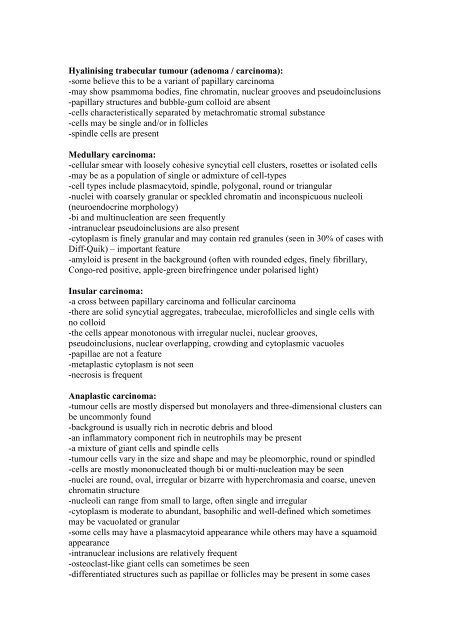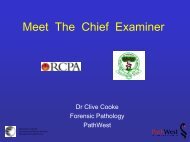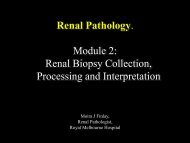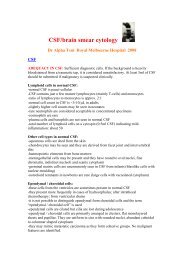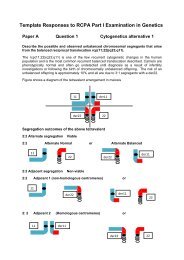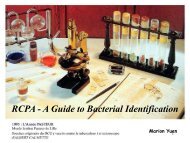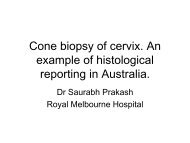Thyroid cytology - RCPA
Thyroid cytology - RCPA
Thyroid cytology - RCPA
You also want an ePaper? Increase the reach of your titles
YUMPU automatically turns print PDFs into web optimized ePapers that Google loves.
Hyalinising trabecular tumour (adenoma / carcinoma):<br />
-some believe this to be a variant of papillary carcinoma<br />
-may show psammoma bodies, fine chromatin, nuclear grooves and pseudoinclusions<br />
-papillary structures and bubble-gum colloid are absent<br />
-cells characteristically separated by metachromatic stromal substance<br />
-cells may be single and/or in follicles<br />
-spindle cells are present<br />
Medullary carcinoma:<br />
-cellular smear with loosely cohesive syncytial cell clusters, rosettes or isolated cells<br />
-may be as a population of single or admixture of cell-types<br />
-cell types include plasmacytoid, spindle, polygonal, round or triangular<br />
-nuclei with coarsely granular or speckled chromatin and inconspicuous nucleoli<br />
(neuroendocrine morphology)<br />
-bi and multinucleation are seen frequently<br />
-intranuclear pseudoinclusions are also present<br />
-cytoplasm is finely granular and may contain red granules (seen in 30% of cases with<br />
Diff-Quik) – important feature<br />
-amyloid is present in the background (often with rounded edges, finely fibrillary,<br />
Congo-red positive, apple-green birefringence under polarised light)<br />
Insular carcinoma:<br />
-a cross between papillary carcinoma and follicular carcinoma<br />
-there are solid syncytial aggregates, trabeculae, microfollicles and single cells with<br />
no colloid<br />
-the cells appear monotonous with irregular nuclei, nuclear grooves,<br />
pseudoinclusions, nuclear overlapping, crowding and cytoplasmic vacuoles<br />
-papillae are not a feature<br />
-metaplastic cytoplasm is not seen<br />
-necrosis is frequent<br />
Anaplastic carcinoma:<br />
-tumour cells are mostly dispersed but monolayers and three-dimensional clusters can<br />
be uncommonly found<br />
-background is usually rich in necrotic debris and blood<br />
-an inflammatory component rich in neutrophils may be present<br />
-a mixture of giant cells and spindle cells<br />
-tumour cells vary in the size and shape and may be pleomorphic, round or spindled<br />
-cells are mostly mononucleated though bi or multi-nucleation may be seen<br />
-nuclei are round, oval, irregular or bizarre with hyperchromasia and coarse, uneven<br />
chromatin structure<br />
-nucleoli can range from small to large, often single and irregular<br />
-cytoplasm is moderate to abundant, basophilic and well-defined which sometimes<br />
may be vacuolated or granular<br />
-some cells may have a plasmacytoid appearance while others may have a squamoid<br />
appearance<br />
-intranuclear inclusions are relatively frequent<br />
-osteoclast-like giant cells can sometimes be seen<br />
-differentiated structures such as papillae or follicles may be present in some cases


